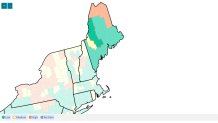
Two omicron subvariants of the highly transmissible BA.2 strain are continuing to fuel significant community spread across New England.
The emergence of subvariants BA.2.12 and BA.2.12.1, both sublineages of the BA.2 strain that some have described as the most contagious version of COVID yet, comes as that parent subvariant intensifies its already-dominant grip on America and New England, where data shows it's circulating at a faster rate than nationally.
WATCH ANYTIME FOR FREE
>Stream NBC10 Boston news for free, 24/7, wherever you are. |
Centers for Disease Control and Prevention data puts BA.2's prevalence at over 95% of cases in New England. That's compared to about 93% nationally.
Sign up for our Breaking newsletter to get the most urgent news stories in your inbox.
Get updates on what's happening in Boston to your inbox. Sign up for our >News Headlines newsletter.
BA.2 is said to be inherently more transmissible than the original omicron strain — perhaps the most contagious form of the virus to date, according to a WHO official — but has not been scientifically linked to more severe cases or proven to be more vaccine-resistant to this point, which is cause for caution but no alarm, experts say.
Anecdotally, reported symptoms are often exceptionally mild — like those common with an innocuous cold that wouldn't otherwise lay people out. In the case of BA.2, though, positive tests could last for days, complicating matters for a region and a country fervently trying to reassert its footing amid the pandemic recovery effort.
Where in Massachusetts is community transmission the highest?
Outside of the Northeast, only a handful of America's more than 3,200 counties are considered high risk by the CDC, based on the latest datat from its community level threat tracker. Most of U.S. counties are still considered low risk.
Parts of Massachusetts, though, are now in the CDC's medium-risk zone.
Counties designated as medium risk include Berkshire, Hampshire, Middlesex and Suffolk, according to the CDC's website. The rest of the state is considered low risk.

What about the rest of New England?
In New Hampshire, Grafton County is designated as high risk, while Coos and Sullivan counties are medium risk. The rest of the state is considered low risk.
In Vermont, Bennington and Washington counties are designated as high risk, while Chittenden, Essex, Franklin, Grand Isle, Lamoille, Orange, Orleans and Windsor counties are all medium risk. The rest of the state is low risk.
Maine's Aroostook County is listed as high risk, while Franklin County is listed as medium risk.
All of Rhode Island is currently designated as medium risk.
And the entire state of Connecticut is considered low risk.
Residents in counties with a high level of community spread are urged to wear masks indoors in public and on public transportation, to stay up to date with vaccines and to get tested if they have symptoms, according to the CDC.
Residents in areas with a medium level of community spread are encouraged to wear a mask if they have symptoms, a positive test or exposure to someone with COVID-19. Anyone at high risk for severe illness should also consider wearing a mask indoors in public and taking additional precautions, the CDC says.
Across the U.S., cases are nowhere near the pandemic peak of about 800,000 new cases a day that were reported in mid-January. New infections are currently averaging about 35,000 a day, according to a CNBC analysis of data compiled by Johns Hopkins University. Still, cases have started edging up nationwide in recent weeks and some areas of the country are seeing localized surges.
Brigham and Women's Hospital's Chief of Infectious Disease Dr. Daniel Kuritzkes said last week that it's possible that holiday gatherings, events like the Boston Marathon and April school vacation week could result in a further uptick.
"All of the family gatherings... may have the potential for some increased transmission," he said. "We are just going to have to wait and see what happens. It is very hard to predict if this bump will take off as a major spike or if it's just going to be a blip."



